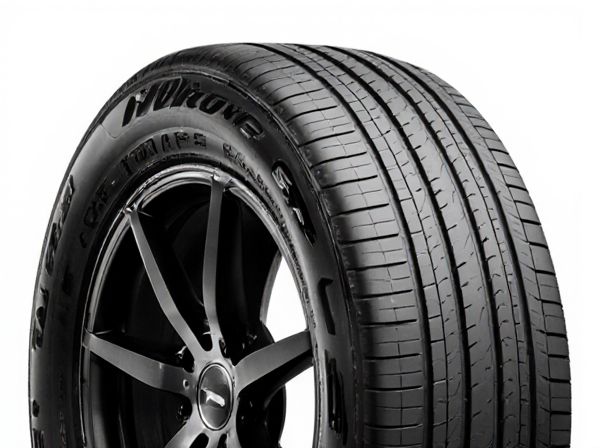
Photo illustration: Directional Tread vs Asymmetrical Tread
Directional tread tires feature a V-shaped pattern designed to enhance water evacuation and improve wet traction, making them ideal for high-speed driving in rainy conditions. Asymmetrical tread tires combine different tread patterns on the inner and outer sides to optimize cornering grip and improve overall performance on dry and wet surfaces. You can choose directional tread for better straight-line stability or asymmetrical tread for balanced handling and versatility.
Table of Comparison
| Feature | Directional Tread | Asymmetrical Tread |
|---|---|---|
| Tread Pattern | V-shaped, designed to rotate in one direction | Different inner and outer tread patterns on the same tire |
| Water Evacuation | Excellent, reduces hydroplaning effectively | Good, balances water dispersion and dry grip |
| Performance | Optimized for wet and snow traction | Enhanced cornering and dry road handling |
| Rotation Options | Limited to same direction only | Flexible, can rotate front-to-back and side-to-side |
| Noise Level | Moderate, may produce humming noise | Generally quieter on highways |
| Wear | Even wear if rotated correctly | More uniform wear due to rotation flexibility |
| Ideal Use | Performance in wet/snow driving conditions | All-around performance and better dry grip |
Understanding Tread Patterns: Directional vs Asymmetrical
Directional tread patterns feature a V-shaped design optimized for efficient water evacuation and enhanced high-speed stability, commonly found on performance tires. Asymmetrical tread patterns combine different designs on the inner and outer sections to improve cornering grip and wet traction, offering versatile performance in various driving conditions. Understanding these tread patterns helps drivers select tires that balance hydroplaning resistance, handling precision, and tire wear based on their specific driving needs.
What Is a Directional Tread Tire?
A directional tread tire features a V-shaped or arrow-like pattern designed to optimize water evacuation and improve wet traction by channeling water away from the contact patch. This tread design enhances high-speed stability and reduces hydroplaning risks by maintaining better road contact in wet conditions. Directional tires must be mounted to rotate in a specific direction, which is indicated by an arrow on the sidewall for proper performance.
Key Features of Directional Tread Design
Directional tread features a V-shaped pattern designed to channel water away from the tire, reducing hydroplaning and enhancing wet traction. This tread design offers improved stability and handling at higher speeds due to its optimized groove orientation. Unlike asymmetrical treads, directional patterns require proper mounting to maintain performance benefits and ensure safety.
What Is an Asymmetrical Tread Tire?
An asymmetrical tread tire features different tread patterns on the inner and outer sections of the tire to enhance handling, traction, and performance in various driving conditions. The outer tread blocks provide improved cornering grip and stability, while the inner tread design aids in water dispersion and wet traction. This design allows optimal performance on both dry and wet roads compared to directional tread tires, which have a uniform pattern designed specifically for one rotational direction.
Unique Characteristics of Asymmetrical Tread Patterns
Asymmetrical tread patterns feature distinct inner and outer tread designs, optimizing performance by combining enhanced cornering grip on the outer edge with improved water evacuation and wet traction on the inner side. This unique configuration provides superior handling and stability across diverse driving conditions compared to directional tread patterns, which prioritize unidirectional water dispersion and high-speed performance. The versatility of asymmetrical treads makes them ideal for drivers seeking balanced performance in both dry and wet environments.
Performance Differences: Wet and Dry Grip
Directional tread patterns offer superior wet grip due to their V-shaped grooves that efficiently channel water away, reducing hydroplaning risk on wet roads. Asymmetrical treads provide enhanced dry grip by combining varying tread blocks and compounds for optimized contact and cornering stability. Performance-driven drivers often choose directional tires for wet conditions and asymmetrical tires for balanced dry road handling and performance versatility.
Which Tread Offers Better Handling?
Directional tread patterns provide superior handling in wet conditions due to their V-shaped grooves that efficiently channel water away, reducing hydroplaning risk. Asymmetrical tread designs enhance dry handling and cornering grip by combining distinct inner and outer tread blocks optimized for different driving needs. For balanced performance, directional treads excel in stability and straight-line traction, while asymmetrical treads offer better versatility and responsiveness during aggressive driving maneuvers.
Rotation and Maintenance: What to Know
Directional tread tires require rotation only front-to-back on the same side to maintain optimal performance and avoid uneven wear. Asymmetrical tread tires offer more flexibility, allowing rotation in various patterns since their tread design accommodates different positions on the vehicle. Proper understanding of rotation guidelines for each tread type enhances tire longevity and ensures balanced handling.
When to Choose Directional or Asymmetrical Tires
Directional tires excel in wet conditions and high-speed stability due to their V-shaped tread pattern, making them ideal for drivers frequently encountering heavy rain or looking for enhanced hydroplaning resistance. Asymmetrical tires offer superior performance versatility by combining distinct tread patterns on the inner and outer sections, providing optimal traction on dry roads as well as effective water evacuation. Choose directional tires for consistent wet weather performance and high-speed handling, while asymmetrical tires suit drivers seeking balanced performance across diverse driving conditions.
Final Verdict: Which Tread Pattern Suits Your Driving Needs?
Directional treads excel in wet conditions by efficiently channeling water away, making them ideal for drivers prioritizing hydroplaning resistance and high-speed stability. Asymmetrical treads balance performance across dry and wet surfaces, offering enhanced cornering grip and longevity suitable for varied driving styles and conditions. Choosing between the two depends on your typical weather, driving style, and performance priorities--directional for optimized water evacuation and asymmetrical for versatile all-season handling.
 caratoz.com
caratoz.com